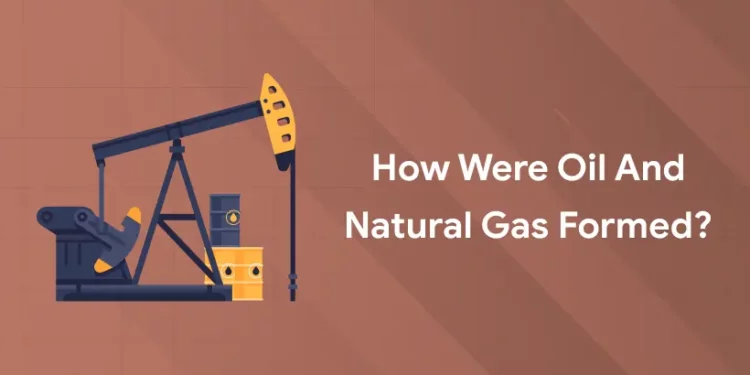Table of Contents
Oil and gas are created from organic material that is deposited on the seafloor as sediments and then degrades and transforms over millions of years. Reservoir rock, cap rock, source rock, and a trap all work together to create an ideal environment for the discovery of viable oil and gas resources.
Get Certified! Get Confident! Join our Oil and Gas Course!
Types of Oil & Natural Gas
Hydrocarbon (H), a chemical molecule formed completely of carbon (C) and hydrogen (H), is the main component of both natural gas and oil. The way molecules are bound and their structures can be used to further classify them into different categories.
Oil
In general, the term “oil” describes a liquid that is mostly made up of hydrocarbons with trace amounts of sulphur (S), nitrogen (N), and oxygen (O). Crude oil is a liquid that is extracted from subterranean oil fields, together with water and gas.
Crude oil is distillable and can be split into oil by using heat and different boiling temperatures. According to its level of density (API*), oil can then be further divided into light, medium, and heavy oils, each of which has a specific usage based on its characteristics.
Uses of Oil
Fuels used to power cars and machinery are petrol (naphtha) and diesel oil, which have a light consistency. Oils with medium to heavy consistency are mostly utilised as fuels for electric power generation and the operation of large machinery, ships, and aircraft. Additionally, heavy oils are utilised as raw materials for chemical items including fibres, plastic products, and bottles.
Natural Gas
Mostly made up of the colourless, odourless, and lighter-than-air gas methane (CH4), natural gas is combustible. Compared to other fossil fuels, natural gas is thought to have a lesser environmental impact due to its reduced emissions of carbon dioxide (CO2), nitrogen oxide (NOx), and sulphur oxide (SOx) during combustion. Liquefied natural gas (LNG) is created by cooling natural gas to 162˚C, or -260˚F.
Uses of Natural Gas
The majority of natural gas is supplied to regular homes and other consumers as city gas. In addition, large-scale industries and industrial facilities, as well as power generating, have a strong demand for it. Chemical goods can also be made using natural gas as a raw source.
How Oil and Gas Forms
1: What is the primary purpose of a refinery in the oil and gas industry?
- When the temperature hits 100°C at 2,000 meters below the surface, kerogen begins to emit hydrocarbons.
- It transforms into oil between 2,000 and 3,800 meters. The oil window is the name given to this depth range.
- Liquid hydrocarbon production peaks at a depth of 3,800–5,000 meters below the surface of the source rock. The resulting liquids became lighter and lighter until finally they transform into the lightest hydrocarbon, methane gas. The gas window is the name given to this depth range.
- Because of the high temperature, there are no hydrocarbons below a depth of 8 to 10 kilometres.
The amount of gas and liquids produced in this manner varies depending on the kind of source rock. It will create more oil than petrol if the organic detritus is primarily made up of animal parts. Gas will be principally produced by the source rock if it is primarily made up of plant debris.
The conversion of dead animals into liquid hydrocarbons takes 60 million years, based on an assumed average sedimentation rate of 50 meters per million years. Therefore, it should come as no surprise that oil is categorised as a non-origin.
The Slow Formation of Source Rock
Just 0.1% of this organic matter manages to avoid this fate. When carried by water, it can occasionally sink to the bottom of a big continental lake or the sea. In these low-oxygen habitats, far from tidal currents, it is partially retained. It mixes with dead sea plankton, which are microscopic organisms, as well as inorganic debris like very fine sand and clay particles. This mixture is turned into mud that smells bad and is dark by germs.
This muck builds up and becomes harder over time. At least 1 to 2% organic content in mud can turn it into source rock, which eventually yields quantities of oil and gas. This % might appear low, but that’s because it needs to meet one or more requirements in order for the process to proceed:
- A warm environment that favours the massive proliferation of plankton.
- A place close to the mouth of a large river that dumps a lot of plant waste.
- There are no mountains in the area that could restrict the amount of inorganic silt in the rock.
Exploration and production of conventional gas resources
Seismic testing techniques similar to those used in petroleum exploration can be used to discover potential methane deposits. In these tests, seismic trucks or more sophisticated three-dimensional instruments are used by gas prospectors to create seismic waves thousands of feet below the surface in underlying rock formations. These tools entail setting off a succession of tiny charges close to the Earth’s surface.
Through the measurement of these waves’ journey periods through the Earth at acoustic receivers called “geophones,” geophysicists are able to determine possible gas deposits and create a picture of the underlying structure. However, an exploratory well needs to be drilled to confirm whether the rock formation indeed contains commercially recoverable amounts of natural gas or other hydrocarbons.
After a site’s feasibility has been established, vertical wells are drilled to reach the reservoir by penetrating the impervious cap rock that covers it. The gas is subsequently carried to the surface by natural buoyancy, where it may be treated and distributed to residences.
Role of Geology in Oil and Gas Investing
Oil and gas are among the world’s most precious natural resources. They provide energy for our vehicles, companies, and residences. Although it can be dangerous, investing in the oil and gas sector can be quite profitable. That’s the role of geology. The greatest locations to drill for oil and gas as well as the most effective ways to extract them are determined in part by geology.
Exploration and Drilling
When it comes to oil and gas investment, geology is crucial during the exploration and drilling stages. To locate possible sources of oil and gas, geologists examine geological formations and make use of seismic imaging. In order to identify the ideal locations for drilling, they also map out the underlying structures using cutting-edge technology.
Risk Management
In order to manage risk while investing in oil and gas, geology is also crucial. Geologists determine the hazards involved in drilling in a certain location by analysing geophysical and geological data. In order to comprehend the hazards connected to natural disasters like earthquakes and floods, they also research the area’s past.
Reservoir Characterization
Geologists continue to be essential in comprehending the properties of the reservoir even after a well is drilled. To find the most effective methods for extracting the oil and gas, they examine the qualities of the rock and fluid. Well performance is optimised and production strategies are developed using this information.
Environmental Impact
Geology is critical for understanding the environmental impact of oil and gas drilling. In order to assess the possible effects of drilling on various plant and animal species, geologists examine the surrounding ecosystem. They examine the possible effects on the quality of the air and water as well.
Economic Analysis
Geologists also play an important part in the economic evaluation of oil and gas projects. They offer data about the reservoir’s dimensions and quality, which is used to calculate the possible return on investment. Investors can use this information to make well-informed judgements on where to put their money.
Conclusion
To summarise, the formation, exploration, and extraction of oil and natural gas are complex processes with deep roots in geology. Most of the energy required by the planet today is produced by these priceless resources, which were generated from organic material over millions of years. The various applications of oil and natural gas in transportation, industry, and power production are determined by their classification, which is based on their composition and qualities.
Entri’s oil and gas course offers comprehensive training for individuals looking to enhance their careers in the energy industry. In addition to covering important topics including drilling, exploration, and production methods, the program places a strong emphasis on environmental laws and safety procedures. This course is a great chance for anybody wishing to advance their knowledge in the oil and gas business since it emphasises high-quality education and practical insights, giving students the tools they need to succeed in the changing energy landscape.
Get Certified! Get Confident! Join our Oil and Gas Course!
Frequently Asked Questions
How is oil and gas produced?
The remains of these animals and plants were buried under layers of sand, silt, and rock for millions of years. The remnants became what we currently refer to as petroleum or crude oil due to heat and pressure from these layers.
Why is oil considered a non-renewable resource?
Because it takes millions of years for oil to originate from organic material under certain geological circumstances, oil is regarded as a non-renewable resource. The rate of oil usage greatly surpasses the
What makes natural gas a better fossil fuel than others?
When compared to other fossil fuels like coal and oil, natural gas emits less carbon dioxide (CO2), nitrogen oxides (NOx), and sulphur oxides (SOx) during combustion, making it a cleaner fuel. It is therefore a recommended option for lessening environmental effect.
Who is the largest consumer of oil in the world?
The United States is currently the world’s leading producer and user of crude oil, with highly populated countries such as China and India following closely behind.
Who is the largest supplier of oil in the world?
Saudi Arabia is the world’s leading oil exporter, followed by Russia and Canada.










